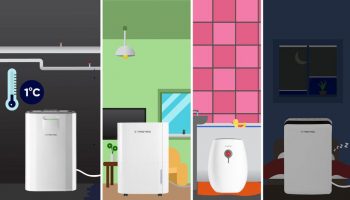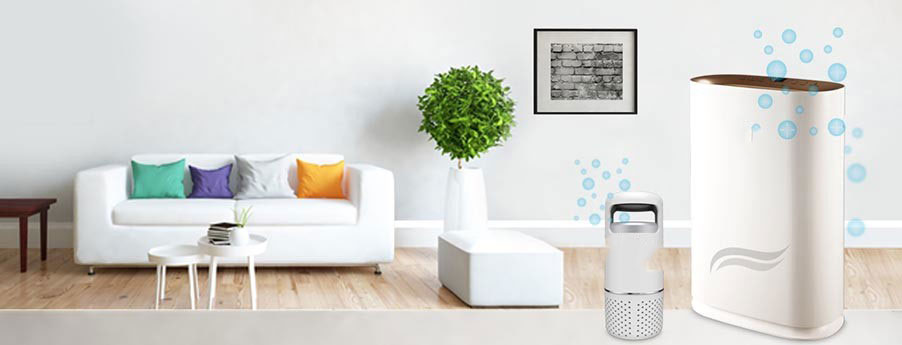The air quality in most homes suffers from three main problems. It’s too humid, too dry, or filled with air pollutants. Often climate plays a role in this. For example, during the winter the air inside gets dry because of the heating. In the summer, the air is more humid even if the house is well aired out.
That means that not every house has the same issue with air. Also, one family’s solution isn’t right for another. Indoor air quality also plays a role in people’s health. So, what makes air good for us? Three key factors contribute to the condition of indoor air. They are freshness, cleanliness, and the right humidity level.
Contrary to popular belief, dehumidifiers, air purifiers, and humidifiers are different things. A lot of people confuse these three appliances, but they do very different things. Luckily, we are here to explain the differences between them. We also explain their purposes, features, and the various models of each category.
We, at HumidityExpert.org, want to help you get the best air quality inside your home. That’s why our site is devoted to showing you the top products in each class. We have also created comprehensive reviews on them. Get educated and get the right unit for your home!
Dehumidifiers: What are They and What Do They Do?

As a result of a dehumidifier’s job, the humidity levels in your home drop significantly. You can see how much humidity was in the air from the collected water. That being said, you have to dispose of the water when the container reaches its maximum. Keep in mind that with a small dehumidifier, you’ll need to throw the water away more often. However, there are models with pump drainage which do not use water tanks, but they are connected to a sink or a drain.
By using a dehumidifier, you can rest assured that microbes and mold spores, who need humidity to live, will die off as well. More often than not, basements have huge problems with mold and mildew. Using a good dehumidifier in the basement will guarantee you a fungus-free space. Additionally, the humidity and fungus give the space an unpleasant smell that will be gone with such a device. If you live in an area where the air is always humid, you definitely need such a product. What is more, bringing the moisture levels in your home down can help for appliances and gun-safety. You can find more information in our post about gun-safe dehumidifiers.
Types of Dehumidifiers
When it comes to dehumidifiers, there are several types that you could go for:
· Thermo-Electric Dehumidifier
Also called a peltier dehumidifier, this is one of the most popular choices when it comes to dehumidifiers. It is also the most affordable option. This type of humidifier takes the humid air from the room, cools it, dehumidifies it, and then releases it back into the room. In a way, you could say that it works just like air conditioning.
The only problem posed by these units is that you can’t use them effectively at very low temperatures. Since they work by cooling the air – they do not work if the air has already been previously cooled. This is why their use is not recommended in subzero temperatures.
· Desiccant Dehumidifier
Those living or working in subzero climates might benefit from desiccant dehumidifiers since they work by absorbing the moisture rather than cool and treat it.
Unlike Peltier dehumidifiers, a desiccant model will not cool the air before dehumidifying it. All it needs is to pass it through a desiccant that will pull out the moisture. Popular desiccants include silica gel that can be dried and reused after each use. Some modern products even use liquid desiccant technology, since it has been proven useful in extracting moisture from the air. These types of dehumidifiers are generally more compact and also more silent.
· Commercial Grade Dehumidifier
If you have a bigger place to dehumidify, such as a small building or a warehouse, then you might want to go for a commercial-grade dehumidifier. If you’re looking for a unit that is this powerful and wish to know more about them, see our article and reviews on commercial-grade dehumidifiers.
Capacity and Sizes of Dehumidifiers
Having explained the types, we must add that there are different dehumidifier capacities and sizes. Their sizes vary from 30 to 130 pints of water tanks.
- For example, the 30-pint dehumidifiers are ideal for the bedroom or a small basement. Such a product is suitable for use in kids’ rooms.
- Medium-sized homes require correspondingly sized dehumidifiers. Such units collect 50 pints of water in 24 hours. If your house is between 300 and 800 sq.ft., then check our reviews on 50-pint dehumidifiers and choose the best one for you.
- Some dehumidifiers are large enough to collect the humidity from the entire house or up to 2500 sq.ft. If you’re interested in buying this big of a unit, then check out our 70-pint dehumidifies buying guide and reviewsfor more information.
There are bigger units that can are used for bigger houses, up to 5200 sq. ft. If you want to know more about the products with large capacities, check our reviews on whole-house dehumidifiers.
Humidifiers: What are They and How Do They Work?

Dry indoor air causes problems like chapped lips or skin but can also be the reason for various respiratory issues. When the air gets enough moisture, these problems can be reduced. As we said above, the ideal humidity percentage indoors is between 40% and 50%.
Types of Humidifiers
Here are several of the most used types of humidifiers:
- Cool mist products release cool vapor into the air. These models use a special filter that stops the air pollutants before releasing the cooler air. Such humidifiers are best for warmer climates and are safer for houses with children. However, these products are noisier and need more maintenance than their counterparts. For more advantages and disadvantages of these devices, check our cool mist humidifiers reviews.
- Warm mist units work by heating water to create a warm vapor to release into the air. They function similarly to the cool mist products, but there are a couple of differences. You can read more about warm mist humidifiers and their pros and cons to get a better idea about them.
- Ultrasonic humidifiers use a metallic diaphragm that vibrates. The high frequencies create water droplets and a fan disperses them into the air. Very little energy is used, and they don’t make any noise. These are great for using in bedrooms at night. Moreover, most of the travel-sized humidifiers are from this type. If you are interested in reading about this option, see our post about travel humidifiers.
Humidifiers Types to Relieve Health Problems
Aside from the dry lips and skin issues, some of the respiratory issues are dry cough, nose, and throat irritation. Additionally, people with allergies or health issues related to respiration can experience severe problems. A good whole-house humidifier can help with all of these problems.
Humidifiers can help relieve the following:
- Sinus problems can begin when the air dries the nose, and the mucous membrane in your respiratory tract is inflamed. This inflammation can also increase the risk of catching the flu or a cold. We have a guide on first-rate humidifiers for sinus problems for you to check out.
- People with asthma can have more severe problems if the air is too cold or too dry. For them, it’s essential to maintain the proper levels of air humidity. So if you wonder is a humidifier good for asthma, the answer is yes. Such a product will improve indoor air quality and relieve your asthma attacks at home.
- Allergy symptoms can get worse if the nasal passages get irritated. This is often caused by dry air. Sometimes severe symptoms can lead to a sinus infection, so it’s essential to keep the air in your home at the ideal humidity levels. You can check out our detailed post on humidifiers for allergies if you need more information.
- Eczema flare-ups often occur when the skin gets too dry. That can be caused by various reasons. One of which is the dry air in your home, especially in the wintertime. Sometimes using hydrating creams isn’t enough. Buying a good humidifier can relieve eczema all year round. See more on the topic in our ultimate guide about humidifiers that relieve eczema.
Air Purifiers: What they are, and What is Their Job?

There are different types of filters used – fiber, fiberglass, mesh, paper, even UV. Regardless of what type of filter it is, it must be changed regularly.
What these devices can remove from the air is dust, smoke from cooking or tobacco, pollen, pet dander, etc. However, they do not remove VOCs or radon. Air purifiers are also ideal for people who have allergies or asthma. We recommend that you look at our exclusive guide on air purifiers for mold and viruses so that you can get acquainted how exactly such devices improve your health.
Types of Air Purifiers
These machines use different purifying techniques. Here are a few of the types available on the market:
- High-efficiency particulate arrestance (HEPA filters) is the most commonly used type of filter used in air purifiers.
- Activated carbon absorbs the volatile chemicals and transforms them form a gas to a solid phase, thus removing them from the air.
- Ionizing purifiers work by creating ions with oppositely charged particles to collect the pollutants from the air.
- UV light renders the micro-organisms in the air sterile and thus harmless to you and your family.
Wrap up
So now you know the differences between air purifiers, humidifiers and dehumidifiers and what each one does. Based on the air quality in your home and the size of your home, you now know which device you need. Don’t wait – dive into our articles and explore the variety of these devices. Don’t forget to pick the one you need and leave us a comment.
